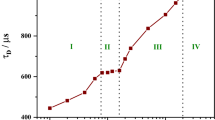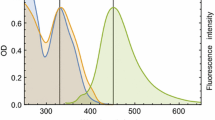Abstract
The molecular mobility of the fluorescent probe, N-(carboxymethyl)imide of 4-(dimethylamino)naphthalic acid (K-35), in three types of binding site on a human serum albumin (HSA) molecule has been studied. Study of the time-resolved decay of K-35 polarized fluorescence in HSA has shown that probe molecules bound to different sites have different fluorescence decay times, which poses problems in interpreting the polarization curves. However, it has been found that, in the case of rather slow thermal rotation of the probe, the decay of the vertical and the horizontal components of polarized fluorescence can each be approximated with three exponentials corresponding to three types of binding site. The mobility of the probe in different sites was estimated. The mobility was different but in all cases hindered by tens of times relative to the rotation of K-35 in water. The slowest motion occurred in the sites of the first type localized in the region of the well known drug site I: there the rotational correlation time was at least 72 ns. In the sites of the second type, this time was about 40 ns, and in the sites of the third type, about 10 ns. The faster was the rotation, the higher was the fluorescence quenching rate. Probably, it is this motion that is responsible for different fluorescence decay times in different HSA sites.
Similar content being viewed by others
References
Yu. A. Gryzunov and G. E. Dobretsov, in Protein Conformation: New Research, Ed. by L.B. Roswell (Nova Publishers, New York, 2008), pp. 125–159.
Y. A. Gryzunov, I. O. Zaks, V. V. Moroz, et al., Anesteziol. Reanimatol. no. 6, 68 (2004).
Blood Serum Albumin in Clinical Medicine, Ed. by Yu. A. Gryzunov and G. E. Dobretsov (GEOTAR, Moscow, 1998), Book 2 [in Russian].
G. E. Dobretsov, Yu. A. Gryzunov, N. V. Smolina, et al., Efferent. Fiz.-Khim. Med. 1(1), 16 (2009).
G. E. Dobretsov, T. I. Syreishchikova, Yu. A. Gryzunov, et al., Biofizika 55(2), 213 (2010).
E. L. Rachofsky and W. R. Laws, Methods Enzimol. 321, 216 (2000).
E. Feinstein, G. Deikus, E. Rusinova, et al., Biophys. J. 84, 599 (2003).
J. R. Lakowicz, Principles of Fluorescence Spectroscopy (Kluwer Academic/Plenum Publishers, New York, 2000).
Author information
Authors and Affiliations
Corresponding author
Additional information
Original Russian Text © G.E. Dobretsov, T.I. Syreishchikova, N.V. Smolina, 2011, published in Biofizika, 2011, Vol. 56, No. 3, pp. 415–419.
Rights and permissions
About this article
Cite this article
Dobretsov, G.E., Syreishchikova, T.I. & Smolina, N.V. Molecular mobility of a fluorescent probe in binding sites of an albumin molecule. BIOPHYSICS 56, 403–406 (2011). https://doi.org/10.1134/S0006350911030079
Received:
Accepted:
Published:
Issue Date:
DOI: https://doi.org/10.1134/S0006350911030079




